List of Cultural Properties of Tōdai-ji
This page lacks images; please help Wikipedia by Uploading your images to Commons
This list is of the Cultural Properties of Tōdai-ji, Nara, Japan.
Structures
| Image | Name | Date | Architecture | Other Comments | Designation |
|---|---|---|---|---|---|
| East corridor 東廻廊 higashi kairō[1] | 1716-37 | 41x1 bay, single-storey, tiled roof | kairō | ICP | |
| West corridor 西廻廊 nishi kairō[2] | 1716-37 | 41x1 bay, single-storey, tiled roof | kairō | ICP | |
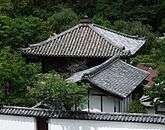 | Founder's Hall 開山堂 kaisandō[3] | 1200-50 | 3x3 bay, single-storey, hōgyō-zukuri, tiled roof | kaisandō | NT |
| Repository 勧進所経庫 kanjinshokyōko[4] | 794-929 | 3x3 bay, azekura, yosemune-zukuri, tiled roof | Repository for donations | ICP | |
 | Kondō (Daibutsuden) (金堂 (大仏殿))[5] | 1705 | 5x5 bay, single-storey with mokoshi, yosemune-zukuri, tiled roof, copper-tiled karahafu | NT | |
| Gorintō (五輪塔)[6] | 1185-1274 | ICP | |||
| Sanmaidō (Shigatsudō) (三昧堂(四月堂))[7] | 1681 | 3x3 bay, twin-storey, yosemune-zukuri, tiled roof | ICP | ||
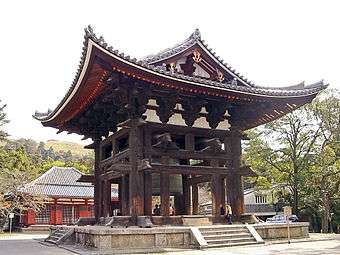 | Shōrō (鐘楼)[8] | 1207-10 | 1x1 bay, single-storey, irimoya-zukuri, tiled roof | NT | |
| Ōyuya (大湯屋)[9] | 1408 | 8x5 bay, single-storey, irimoya-zukuri front, kirizuma-zukuri rear, tiled roof, tsumairi | Bath-house | ICP | |
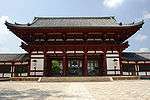 | Chūmon (中門)[10] | 1714 | 5 bay, three-door rōmon, tiled roof | ICP | |
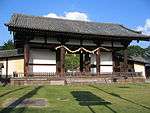 | Tegaimon (転害門)[11] | Nara period | 3 bay, single-door hakkyakumon, kirizuma-zukuri, tiled roof | NT | |
| Tōzaigakumon (East) (東西楽門 (東))[12] | 1722 | 3 bay, single-door hakkyakumon, kirizuma-zukuri, tiled roof | ICP | ||
| Tōzaigakumon (West) (東西楽門 (西))[13] | 1719 | 3 bay, single-door hakkyakumon, kirizuma-zukuri, tiled roof | ICP | ||
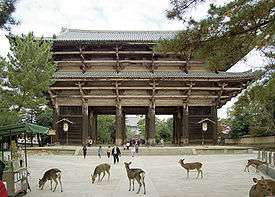 | Nandaimon (南大門)[14] | 1199 | 5 bay, three-door, twin-storey, irimoya-zukuri, tiled-roof | NT | |
 | Nigatsu-dō (二月堂)[15] | 1669 | 10x7 bay, single-storey, yosemune-zukuri, tiled-roof | NT | |
| Nigatsu-dō sanrōsho (二月堂参籠所)[15] | 1277-1282 | 5x4 bay, single-storey, kirizuma-zukuri, tiled-roof | For seclusion and prayer | ICP | |
| Nigatsu-dō busshōya (gokūsho) (二月堂仏餉屋(御供所))[16] | 1185-1274 | 5x2 bay, single-storey, kirizuma-zukuri, tiled-roof | For preparation of ritual food offerings | ICP | |
| Nigatsu-dō akaiya (wakasaiya) (二月堂閼伽井屋(若狭井屋))[17] | 1275-1332 | 3x2 bay, single-storey, kirizuma-zukuri, tiled-roof | Double well for serving Buddha | ICP | |
| Nembutsu-dō (念仏堂)[18] | 1237 | 3x3 bay, single-storey, yosemune-zukuri, tiled-roof | ICP | ||
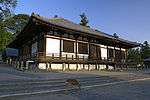 | Hokke-dō (法華堂)[19] | 747, 1199 | 5x8 bay, single-storey, irimoya-zukuri front, yosemune-zukuri rear, tiled-roof | NT | |
| Hokke-dō repository (法華堂経庫)[20] | 794-929 | 3x3 bay, azekura, yosemune-zukuri, tiled-roof | ICP | ||
| Hokke-dō temizuya (法華堂手水屋)[21] | 1335 | 7x4 bay, kirizuma-zukuri, tiled-roof | ICP | ||
| Hokke-dō north gate (法華堂北門)[22] | 1240 | four-post, kirizuma-zukuri, tiled-roof | ICP | ||
 | Repository 本坊経庫 honbōkyōko[23] | 710-793 | 3x2 bay, azekura, yosemune-zukuri, tiled-roof | NT | |
| Shingon'in kanjōdō 東大寺真言院灌頂堂 Tōdai-ji Shingon'in kanjōdō[24] | 1649 & following | Prefectural | |||
| Shingon'in front gate 東大寺真言院表門 Tōdai-ji Shingon'in omotemon[24] | 1649 & following | Prefectural | |||
| Shingon'in Jizōdō 東大寺真言院地蔵堂 Tōdai-ji Shingon'in Jizōdō[24] | 1649 & following | Prefectural | |||
| Shingon'in kangodono 東大寺真言院神護殿 Tōdai-ji Shingon'in kangodono[24] | 1649 & following | Prefectural | |||
| Shingon'in akaiya 東大寺真言院閼伽井屋 Tōdai-ji Shingon'in akaiya[24] | 1649 & following | Prefectural | |||
| Shingon'in shōrō 東大寺真言院鐘楼 Tōdai-ji Shingon'in shōrō[24] | 1649 & following | Prefectural | |||
| Shingon'in south gate 東大寺真言院南門 Tōdai-ji Shingon'in nanmon[24] | 1649 & following | Prefectural | |||
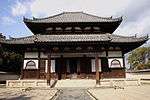 | Kaidan'in kaidandō 東大寺戒壇院戒壇堂 Tōdai-ji Nigatsudō yuya[24] | 1733 | Prefectural | ||
| Nigatsudō bath house 東大寺二月堂湯屋 Tōdai-ji Nigatsudō yuya[24] | mid-Edo period | Prefectural | |||
Paintings
| Image | Name | Date | Medium | Other Comments | Designation |
|---|---|---|---|---|---|
| Kusha mandala 絹本著色倶舎曼荼羅図 kenpon chakushoku kusha mandarazu[25] | Heian period (C12) | mandala of the Kusha school | NT | ||
.jpg) | Zenzai Dōji's pilgrimage to the fifty-five places described in the Kegon Sutra 紙本著色華厳五十五所絵巻 shihon chakushoku Kegon gojūgosho emaki[26][27] | twelfth century | on coloured paper; picture scroll | illustrated stories of the boy Sudhana's pilgrimage | NT |
.jpg) | Portrait of Kōzō Daishi 絹本著色香象大師像 kenpon chakushoku Kōzō Daishi zō[27][28] | Kamakura period (C13) | colours on silk | one of the five patriarchs of the Kegon school | ICP |
.jpg) | Spiritual Teachers of the Kegon Ocean Assembly 絹本著色華厳海会善知識曼荼羅図 kenpon chakushoku Kegon kaie zenchishiki mandara zu[27][29] | 1294 | colours on silk | assembly of those consulted by Zenzai Dōji; painted by Raien for Kōzan-ji; transferred to Tōdai-ji in 1421 | ICP |
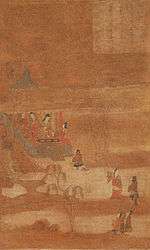 | Fifty-five places described in the Kegon Sutra 絹本著色華厳五十五所絵 kenpon chakushoku Kegon gojūgosho e[27][30][31] | Heian period | colours on silk | ten paintings from the twenty that are extant; the others are owned by the Fujita Art Museum, Nezu Museum, and Nara National Museum | ICP |
.jpg) | Legends of the Daibutsu 紙本著色東大寺大仏縁起 shihon chakushoku Tōdai-ji daibutsu engi[27][32] | 1536 | colours on silk | illustrated legends of the daibutsu which, alongside the Legends of Hachiman, were copied and used in fundraising throughout Japan for repairs to the Daibutsuden; by Rinken; three scrolls | ICP |
.jpg) | Portrait of Kashō Daishi 絹本著色嘉祥大師像 kenpon chakushoku Kashō Daishi zō[27][33] | Kamakura period (C13) | colours on silk | Jizang (549-623), patriarch of the Sanron school | ICP |
.jpg) | Portrait of Jōei Daishi 絹本著色浄影大師像 kenpon chakushoku Jōei Daishi zō[27][34] | Kamakura period (C13) | colours on silk | Hui Yuan (523-592), patriarch of the Sanron school, from Dunhuang, known as the "Commentator Priest" | ICP |
| Four Saintly Persons 絹本著色四聖御影 kenpon chakushoku shishōnomie[27][35] | 1256 | colours on silk | key figures in the history of Tōdai-ji: Emperor Shōmu, Rōben, Bodhisena, and Gyōki | ICP | |
_Todaiji.jpg) | Four Saintly Persons 絹本著色四聖御影 kenpon chakushoku shishōnomie[27][36] | 1377 | colours on silk | key figures in the history of Tōdai-ji: Emperor Shōmu (rear left), Rōben (front left), Bodhisena (rear right), and Gyōki (front right); by Hokkyō Kanjō from Mino Province; copy of the 1256 version | ICP |
| Eleven-headed Kannon 絹本著色十一面観音像 kenpon chakushoku Jūichimen Kannon zō[37] | Kamakura period | colours on silk | Jūichimen Kannon | ICP | |
| Nigatsudō mandala 二月堂曼荼羅図 Nigatsudō mandara zu[24] | Muromachi period | mandala | Prefectural | ||
| History and legends of Tōdai-ji 絹本著色東大寺縁起図 kenpon chakushoku Tōdaiji engi zu[24] | Kamakura period | colours on silk | two items | Prefectural | |
.jpg) | Shaka triad with Sixteen Rakan 絹本著色釈迦三尊十六羅漢像 kenpon chakushoku Shaka sanzon jūroku rakan zō[27][38] | Kamakura period (C14) | colours on silk | Shaka and Sixteen Rakan | Municipal |
Sculptures
| Image | Name | Date | Medium | Other Comments | Designation |
|---|---|---|---|---|---|
| Bonten 乾漆梵天立像 kanshitsu Bonten ryūzō[39] | Nara period | dry lacquer | standing statue of Bonten; enshrined at the Hokkedō | NT | |
| Taishakuten 乾漆帝釈天立像 kanshitsu Taishakuten ryūzō[39] | Nara period | dry lacquer | standing statue of Taishakuten; enshrined at the Hokkedō | NT | |
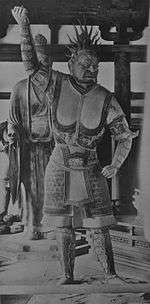 | Kongō Rikishi 乾漆金剛力士立像 kanshitsu Taishakuten ryūzō[40][41] | Nara period | dry lacquer | standing statue of Agyō; enshrined at the Hokkedō | NT |
| Kongō Rikishi 乾漆金剛力士立像 kanshitsu Taishakuten ryūzō[40][41] | Nara period | dry lacquer | standing statue of Ungyō; enshrined at the Hokkedō | NT | |
| Four Heavenly Kings 乾漆四天王立像 kanshitsu shitennō ryūzō[42] | Nara period | dry lacquer | standing statue of Jikoku-ten; enshrined at the Hokkedō | NT | |
| Four Heavenly Kings 乾漆四天王立像 kanshitsu shitennō ryūzō[42] | Nara period | dry lacquer | standing statue of Zōjō-ten; enshrined at the Hokkedō | NT | |
_(233).jpg) | Four Heavenly Kings 乾漆四天王立像 kanshitsu shitennō ryūzō[42] | Nara period | dry lacquer | standing statue of Kōmoku-ten; enshrined at the Hokkedō | NT |
| Four Heavenly Kings 乾漆四天王立像 kanshitsu shitennō ryūzō[42] | Nara period | dry lacquer | standing statue of Tamon-ten; enshrined at the Hokkedō | NT | |
.jpg) | Fukūkensaku Kannon 乾漆不空羂索観音立像 kanshitsu Fukū Kensaku Kannon ryūzō[43] | Nara period | dry lacquer | standing statue of Fukūkensaku Kannon; enshrined at the Hokkedō | NT |
.jpg) | Nikkō Bosatsu 塑造日光仏立像 sozō Nikkō butsu ryūzō[44] | Nara period | clay | standing statue of Nikkō Bosatsu; enshrined at the Hokkedō | NT |
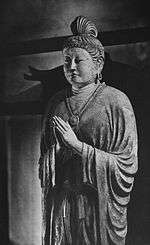 | Gakkō Bosatsu 塑造月光仏立像 sozō Gakkō butsu ryūzō[44] | Nara period | clay | standing statue of Gakkō Bosatsu; enshrined at the Hokkedō | NT |
_(229).jpg) | Four Heavenly Kings 塑造四天王立像 sozō shitennō ryūzō[45] | Nara period | clay | standing statue of Jikoku-ten; enshrined at the Kaidandō | NT |
_(227).jpg) | Four Heavenly Kings 塑造四天王立像 sozō shitennō ryūzō[45] | Nara period | clay | standing statue of Zōjō-ten; enshrined at the Kaidandō | NT |
| Four Heavenly Kings 塑造四天王立像 sozō shitennō ryūzō[45] | Nara period | clay | standing statue of Kōmoku-ten; enshrined at the Kaidandō | NT | |
_(228).jpg) | Four Heavenly Kings 塑造四天王立像 sozō shitennō ryūzō[45] | Nara period | clay | standing statue of Tamon-ten; enshrined at the Kaidandō | NT |
| Shukongōshin 塑造執金剛神立像 sozō shukongōshin ryūzō[46] | Nara period | clay | standing statue of Shukongōshin; enshrined at the Hokkedō | NT | |
| Shaka at Birth 銅造誕生釈迦仏立像 dōzō tanjō Shaka butsu ryūzō[27][41][47][48] | Nara period | bronze | for the ceremony on Buddha's Birthday | NT | |
 | Vairocana 銅造盧舎那仏坐像 dōzō Rushana butsu zazō[49] | 752 | bronze | daibutsu; restored; enshrined at the Daibutsuden | NT |
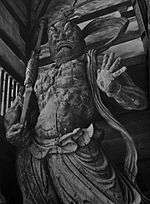 | Kongō Rikishi 木造金剛力士立像 mokuzō kongōrikishi ryūzō[50] | 1203 | wood | standing statue of Agyō; located at the Nandaimon; by Unkei, Kaikei, and 13 assistant sculptors. | NT |
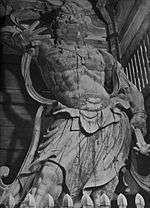 | Kongō Rikishi 木造金剛力士立像 mokuzō kongōrikishi ryūzō[50] | 1203 | wood | standing statue of Ungyō; located at the Nandaimon; by Jōkaku, Tankei, and 12 assistant sculptors | NT |
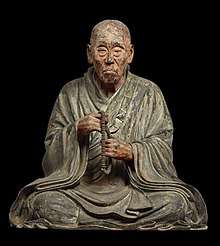 | Chōgen 木造俊乗上人坐像 mokuzō Shunjō shōnin zazō[27][51] | c. 1206 | wood | seated statue of Chōgen, in charge or rebuilding Tōdai-ji after the 1180 fire; enshrined at the Shunjōdō or Chōgen Hall | NT |
.jpg) | Hachiman in the guise of a monk 木造僧形八幡神坐像 mokuzō sōgyō Hachimanjin zazō[27][52] | 1201 | wood | Hachiman in the guise of a monk, by Kaikei; enshrined at the Kanjinsho Hachimanden (see Hachiman shrine and Chinjusha) | NT |
.jpg) | Priest Rōben 木造良弁僧正坐像 mokuzō Rōben sōjō zazō[27][53] | Heian period (late C9) | wood | seated statue of Rōben, founder of Tōdai-ji; enshrined at the Kaisandō or Founder's Hall | NT |
| Shaka Nyorai 木造釈迦如来坐像 mokuzō Shaka Nyorai zazō[27][41][54] | 1225 | wood | seated statue of Shaka Nyorai; by Zen'en (善慶) | ICP | |
.jpg) | Miroku 木造弥勒菩薩坐像 mokuzō Miroku bosatsu zazō[27][41][55] | Heian period | wood | seated statue of Miroku; said to be the personal devotional of Rōben, but generally dated later on stylistic grounds | ICP |
| Amida Nyorai 木造阿弥陀如来坐像 mokuzō Amida Nyorai zazō[56] | Heian period | wood | seated statue of Amida Nyorai; enshrined at the Kangakuin | ICP | |
| Amida Nyorai 木造阿弥陀如来立像 mokuzō Amida Nyorai ryūzō[27][57] | Kamakura period | wood | standing statue of Amida Nyorai; enshrined at the Shunjōdō | ICP | |
| Amida Nyorai 木造阿弥陀如来坐像 mokuzō Amida Nyorai zazō[58] | Kamakura period | wood | seated statue of Amida Nyorai | ICP | |
.jpg) | Stone Lion 石造獅子 sekizō shishi[59] | Kamakura period | stone | shishi by Chin Wakei (陳和卿); at the Nandaimon | ICP |
| Nimbus in the shape of a boat 銅造舟形光背 dōzō funagata kōhai[41][60] | Nara period | bronze | ICP | ||
| Jizō bosatsu 木造地蔵菩薩坐像 mokuzō Jizō bosatsu zazō[61] | Kamakura period | wood | seated statue of Jizō; enshrined at the Hokkedō | ICP | |
| Jizō bosatsu 木造地蔵菩薩坐像 mokuzō Jizō bosatsu zazō[62] | Kamakura period | wood | seated statue of Jizō; enshrined at the Nembutsudō (see Nembutsu) | ICP | |
| Jizō bosatsu 木造地蔵菩薩坐像 mokuzō Jizō bosatsu ryūzō[63] | Kamakura period | wood | standing statue of Jizō | ICP | |
.jpg) | Jizō bosatsu 木造地蔵菩薩坐像 mokuzō Jizō bosatsu ryūzō[27][41][64] | Kamakura period | wood | standing statue of Jizō; by Kaikei; located at the Kōkeidō | ICP |
| Aizen Myōō 木造愛染明王坐像 mokuzō Aizen Myōō zazō[27][65] | Heian period | wood | seated statue of Aizen Myōō; enshrined at the Shunjōdō | ICP | |
| Aizen Myōō 木造愛染明王坐像 mokuzō Aizen Myōō zazō[66] | Muromachi period | wood | seated statue of Aizen Myōō | ICP | |
| Benzaiten 塑造弁財天吉祥天立像 sozō Benzaiten Kisshōten ryūzō[67] | Nara period | clay | standing statue of Benzaiten | ICP | |
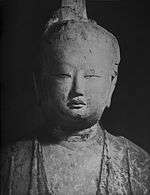 | Kisshōten 塑造弁財天吉祥天立像 sozō Benzaiten Kisshōten ryūzō[67] | Nara period | clay | standing statue of Kisshōten | ICP |
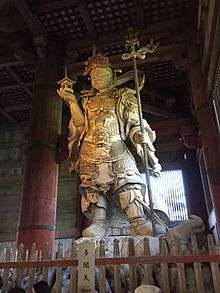 Tamonten Guardian in the Todaiji temple, Kyoto, Japan. | Tamonten 木造多聞天立像 mokuzō Tamonten ryūzō[27][41][68] | 1178 | wood | standing statue of Tamonten | ICP |
| Senjū Kannon 木造千手観音立像 mokuzō Senjū Kannon ryūzō[69] | Heian period | wood | standing statue of the Thousand-armed Kannon; enshrined at the Sanmaidō (Shigatsudō) | ICP | |
| Gokōshii Amida 木造五劫思惟弥陀仏坐像 mokuzō Gokōshii Mida butsu zazō[70] | Muromachi Period | wood | seated statue of Gokōshii Amida; enshrined at the Kangakuin | ICP | |
| Fudō Myōō with two attendants 木造不動明王二童子像 mokuzō Fudō Myōō nidōshizō[27][71] | 1373 | wood | enshrined at the Hokkedō | ICP | |
| Kariteimo 木造訶梨帝母坐像 mokuzō Kariteimo zazō[27][72] | Heian period | wood | seated statue of Kariteimo; enshrined at the Shuni-e shukusho | ICP | |
| Ganjin 木造鑑真和尚坐像 mokuzō Ganjin oshō zazō[27][73] | 1733 | wood | seated statue of Ganjin | ICP | |
| Jikoku-ten 木造持国天立像 mokuzō Jikokuten ryūzō[27][41][74] | Heian period (1178) | wood | standing statue of Jikoku-ten | ICP | |
| Nyoirin Kannon 銅造如意輪観音半跏像 dōzō Nyoirin Kannon hankazō[27][41][75] | Heian period | bronze | half-cross-legged statue of Nyoirin Kannon | ICP | |
| Seimen Kongō 木造青面金剛立像 mokuzō Seimen Kongō ryūzō[27][76] | Heian period | wood | standing statue of Shōmen Kongō | ICP | |
| Twelve Heavenly Generals 木造十二神将立像 mokuzō jūnishinshō ryūzō[27][41][77] | Heian period | wood | twelve standing statues of the Twelve Heavenly Generals | ICP | |
| Four Heavenly Kings 木造四天王立像 mokuzō shitennō ryūzō[78] | 1281 | wood | four standing statues of the Four Heavenly Kings | ICP | |
| Shō Kannon 木造聖観音立像 mokuzō Shō Kannon ryūzō[27][79] | Kamakura period | wood | standing statue of Shō Kannon | ICP | |
| Jūichimen Kannon 木造十一面観音立像 mokuzō Jūichimen Kannon ryūzō[27][80] | Heian period | wood | standing statue of Jūichimen Kannon | ICP | |
| Enma-Ō 木造閻魔王坐像 mokuzō Enma-ō zazō[27][81] | Kamakura period | wood | seated statue of Enma-Ō | ICP | |
| Taizan Fukun 木造泰山府君坐像 mokuzō Taizan Fukun zazō[27][82] | Kamakura period | wood | seated statue of Taizan Fukun | ICP | |
| Bosatsu 木造菩薩立像 mokuzō Bosatsu ryūzō[83] | 1190-98 | wood | standing statue of a bodhisattva | ICP | |
| Nyoirin Kannon & Kokūzō Bosatsu 木造〈如意輪観音/虚空蔵菩薩〉坐像 mokuzō Nyoirin Kannon / Kokūzō Bosatsu zazō[84] | 1726-55 | wood | seated statues of Nyoirin Kannon & Kokūzō Bosatsu; enshrined in the Daibutsuden; Kei school | ICP | |
| Images inside a miniature shrine: Senjū Kannon and Four Heavenly Kings 厨子入/木造千手観音立像/木造四天王立像 zushi-iri/mokuzō Senjū Kannon ryūzō/mokuzō shitennō ryūzō[27][85] | Kamakura period | wood | standing statues of Thousand-armed Kannon and Four Heavenly Kings; enshrined at the Kaidan'in Senjūdō | ICP | |
| Lion head 木造獅子頭 mokuzō shishi gashira[86] | Kamakura period | wood | shishi | ICP | |
| Kōkei 木造公慶上人坐像 mokuzō Kōkei shōnin zazō[27][87] | 1706 | wood | ICP | ||
 | Gigaku masks 木造伎楽面 乾漆伎楽面 mokuzō gigaku men - kanshitsu gigakumen[27][41][88][89] | 752 | for gigaku; wood (29); dry lacquer (1) | thirty inscribed masks | ICP |
| Gigaku masks 木造伎楽面 乾漆伎楽面 mokuzō gigaku men[90] | 1196 | wood | two inscribed masks | ICP | |
| Bugaku masks 木造舞楽面 mokuzō bugaku men[27][41][91] | Heian and Kamakura period | wood | for Bugaku; nine masks | ICP | |
| Gyōdō masks 木造行道面 mokuzō gyōdō men[92] | 1086 & 1334 | wood | for gyōdō; two masks | ICP | |
| Bosatsu masks 木造菩薩面 mokuzō bosatsu men[93] | 1158 | wood | three bodhisattva masks | ICP | |
| Fudō Myōō 木造不動明王坐像 mokuzō Fudō Myōō zazō[24] | Heian period | wood | seated statue of Fudō Myōō | Prefectural | |
Crafts
| Image | Name | Date | Type | Other Comments | Designation |
|---|---|---|---|---|---|
| Kondō consecration objects 東大寺金堂鎭壇具 Tōdaiji kondō chindangu[27][94] | c.750 | designated as "archaeological materials" | Small gilt silver bowl with a hunting motif, swords, armor, a mirror, a fragment of a lacquer box, a crystal box, crystal objects, amber beads, glass beads and 22 crystal beads | NT | |
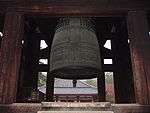 | Temple bell 梵鐘 bonshō[95] | 752 | NT | ||
.jpg) | Octagonal gilt bronze lantern 金銅八角燈籠 kondō hakkaku tōrō[27][96] | Nara period | located in front of the Daibutsuden | NT | |
| Box with flower and bird design 花鳥彩絵油色箱 kachō saieyushokubako[97] | Nara period | NT | |||
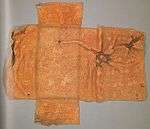 | Deer hide with grape arabesque pattern 葡萄唐草文染韋 budō karakusamon somekawa[27][98] | Nara period | NT | ||
| Imperial plaque for the Saidaimon 木造西大門勅額 mokuzō Saidaimon chokugaku[41][99] | Nara period | ICP | |||
| Bell 梵鐘 bonshō[100] | 1264 | at the Shingon'in | ICP | ||
| Sutra chest with cloud and phoenix design 雲鳳鎗金経櫃 unhōsō kinkyō hitsu[27][101] | Yuan Dynasty | at the Tokyo National Museum; from China | ICP | ||
| Gong with peacock design 孔雀文磬 kujaku monkei[27][102] | Kamakura period | ICP | |||
| Ewer 銅水瓶 dō suibyō[27][103] | 1305 | bronze | with inscription of date and location in the Kaidan'in; two items | ICP | |
| Perfume jars 銅香水杓 dō kōsuishaku[104] | Kamakura period | bronze | four items | ICP | |
| Lock (with key) 鉄鑰鍵付 tetsu yaku (kagi tsuki)[105] | Kamakura period | iron | ICP | ||
| Small bell 堂司鈴 dōshirei[106] | 1285 | ICP | |||
| Bell 梵鐘 bonshō[27][107] | 1308 | located inside the Nigatsudō | ICP | ||
| Waniguchi 鰐口 waniguchi[108] | Kamakura period | ICP | |||
| Lacquer bowls 朱漆布薩盥 shu urushi fusatsu tarai[27][109] | 1427 | three items | ICP | ||
| Lacquer trays 二月堂練行衆盤 Nigatsudō rengyō shūban[27][110] | 1298 | inscribed; from the Nigatsudō; with cedar box; eleven items | ICP | ||
| Vessel 木製黒漆油壺 mokusei kokushitsu abura tsubo[111] | 1330 | wooden core, black lacquer, oil; two items | ICP | ||
| Lacquer drum body 黒漆鼓胴 kokushitsu kodō[112] | Nara period | black lacquer; two items | ICP | ||
| Painted drum body 彩絵鼓胴 sai-e kodō[113] | Kamakura period | ICP | |||
| Painted drum body 彩絵鼓胴 sai-e kodō[114] | 1232 | ICP | |||
.jpg) | Black lacquer table with mother-of-pearl inserts 黒漆螺鈿卓 kokushitsu raden taku[27][115] | Heian period | raden | ICP | |
| Five-lion nyoi 五獅子如意 go shishi nyoi[116] | Heian period | ritual implement decorated with five lions | ICP | ||
| Tortoiseshell nyoi 玳瑁如意 taimai nyoi[117] | Heian period | ICP | |||
| Bathtub 鉄湯船 tetsu yubune[118] | Kamakura period | iron | at the Ōyuya (bath house) | ICP | |
| Iron lanterns 鉄釣燈籠 tetsutsuri tōrō[27][119] | Kamakura period | iron | two "fishing" lanterns; at the Hokkedō | ICP | |
| Stone lantern 石燈籠 ishi dōrō[120] | 1254 | stone | tōrō | ICP | |
| Kane 鉦鼓 shōkō[121] | 1134 | kane (instrument) | ICP | ||
| Kane 鉦鼓 shōkō[122] | 1198 | kane (instrument) | ICP | ||
| Gilt bronze base 金銅受台 kondō ukedai[123] | Nara period | ICP | |||
| Bronze pot 銅鉢 dōhatsu[124] | Nara period | ICP | |||
| Gilt bronze pots 金銅鉢 kondōhatsu[125] | Nara period | two items | ICP | ||
| Gilt bronze hōtō 金銅宝塔 kondō hōtō[24] | 1411 | Prefectural | |||
Documents
| Image | Name | Date | Type | Other Comments | Designation |
|---|---|---|---|---|---|
 | Documents of Tōdai-ji 東大寺文書 Tōdai-ji monjo[126] | Heian to Muromachi period | designated as "ancient documents" | 100 scrolls with 979 mounted documents; 8,516 single-sheet documents | NT |
 | Sutra of the Wise and Foolish 賢愚経 Kengu-kyō[127] | Nara period | one scroll (vol. 15) | NT | |
| Kenkō-kyō 賢劫経 Kenkō-kyō shihonbokusho makimono[128] | Nara period | one scroll | ICP | ||
| Daibibasharon 大毘婆沙論 daibibasharon[129] | 740 | Abhidharma Mahāvibhāṣa Śāstra; one scroll (vol. 23) | ICP | ||
| Annals of Tōdai-ji 東大寺要録 Tōdai-ji yōroku[130] | Kamakura period | ten volumes | ICP | ||
| Annals of Tōdai-ji continued 東大寺要録続録 Tōdai-ji yōroku zokuroku[131] | Muromachi period | nine volumes | ICP | ||
| Daiitoku Darani-kyō 大威徳陀羅尼経 Daiitoku darani-kyō[132] | 740 | ten scrolls | ICP | ||
| Daihōtō daishū bosatsu nenmbutsu sanmai-kyō 大方等大集菩薩念仏三昧経 Daihōtō daishū bosatsu nenmbutsu sanmai-kyō[133] | Nara period | ten scrolls | ICP | ||
| Nirvana Sutra 大般涅槃経 Daihatsu nehan-gyō[134] | Nara period | Nirvana Sutra; forty scrolls | ICP | ||
| Discourse on the Stages of Yogic Practice 瑜伽師地論 Yugashichi-ron[135] | 740 | Yogācārabhūmi Śāstra; four scrolls (12, 13, 14, 17) | ICP | ||
| Flower Garland Sutra 華厳経 Kegon-kyō[136] | 798 | Kegon Sutra; six scrolls (1, 4, 5, 6, 9, 11) | ICP | ||
| Kokūzō-kyō 虚空蔵経 Kokūzō-kyō[137] | Tang Dynasty | from China; eight scrolls | ICP | ||
| Saijikonkōmyōsaishōō-kyō 細字金光明最勝王経 Saijikonkōmyōsaishōō-kyō[138] | Heian period | one scroll | ICP | ||
| Soku Kegon ryakukyō sokanteiki 続華厳略経疏刊定記 soku Kegon ryakukyō sokanteiki[139] | Nara period | five scrolls | ICP | ||
| Hokketōryaku 法華統略 Hokketōryaku[140] | Heian period | one scroll | ICP | ||
| Perfection of Transcendent Wisdom Sutra 金剛般若経 Kongō hannya-kyō[141] | 844 | Prajnaparamita sutra; first scroll | ICP | ||
| Hyakubōkenyūshō 百法顕幽抄 Hyakubōkenyūshō[142] | Tang Dynasty (843) | from China; first scroll | ICP | ||
| Kōsōdenrokushu 高僧伝六種 Kōsōdenrokushu[143] | Kamakura period | nine scrolls | ICP | ||
| Account of the deeds of Enshō 円照上人行状記 Enshō shōnin gyōjōki[144] | 1302 | deeds of Enshō (円照), with brushwork by Gyōnen (凝然); three scrolls | ICP | ||
| Konma 羯磨 Konma[145] | Nara period | two scrolls | ICP | ||
.jpg) | Precepts for Monks and Nuns 弥沙塞羯磨本 Misasoku Konma Bon[27][146] | Nara period | one scroll | ICP | |
.jpg) | Flower Garland Sutra 紺紙金字華厳経 konshi ginji Kegon-kyō[27][147] | Kamakura period | silver ink on dark blue paper | eighty scrolls | ICP |
| Ganmonshū 願文集 ganmonshū[148] | Kamakura period | one scroll | ICP | ||
| Tōdaiji sōshō hitsu shōkyō narabini-shō 東大寺宗性筆聖教並抄録本 Tōdaiji sōshō hitsu shōkyō narabini-shō[149] | Kamakura period | 99 scrolls, 347 sheets | ICP | ||
| Tōdaiji Gyōnen senjutsu shōsorui 東大寺凝然撰述章疏類 Tōdaiji gyōzen senjutsu shōsho-rui[150] | Kamakura period | 146 scrolls | ICP | ||
| Flower Garland Sutra 高麗版華厳経随疏演義鈔 kōraiban Kegon-kyō zuiso engi shō[151] | Joseon Dynasty | from Korea; forty scrolls | ICP | ||
| Konkōmyō-saishōō-kyō chūshaku 金光明最勝王経註釈 Konkōmyōsaishōō-kyō chūshaku[152] | Heian period | two scrolls (5, 9) | ICP | ||
| Tōdai-ji daikanjinsōgyō yūjihitsu shojō 東大寺大勧進僧行勇自筆書状 Tōdai-ji daikanjinsōgyō yūjihitsu shojō[153] | Kamakura period | one volume | ICP | ||
| Inventory of objects for Amida Keka service 紙本墨書阿弥陀悔過料資財帳 shihonbokusho Amida kekaryō shizaichō[154] | 767 | designated as "ancient documents" | one scroll | ICP | |
| Solicitation for funds by Chōgen (Genkyū 2 (1205)) 元久二年重源上人勧進状 Genkyū ninen Chōgen shōnin kanjinjō[155] | 1205 | ancient documents | one scroll | ICP | |
| Register of slaves in Tōdai-ji 東大寺奴婢見来帳 Tōdai-ji nuhiken raichō[156] | 751/6 | ancient documents | one scroll | ICP | |
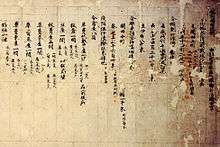 | Record of Tōdai-ji estate in Echizen Province 越前国田使解 Echizen no kuni denshige[157][158][159][160] | 756, 757 | ancient documents | early shōen in Echizen Province; two scrolls (scrolls 2 and 3; scroll 1 from 755 is at the Gotoh Museum) | ICP |
| Eisai jihitsu tōboku hitsukenjōjō 栄西自筆唐墨筆献上状 Eisai jihitsu tōboku hitsukenjōjō[161] | 1270 | ancient documents | one volume | ICP | |
| Sōbō Gekishu ganmonan 僧某逆修願文案 sōbō Gekishu ganmonan[162] | 1198 | ancient documents | one scroll | ICP | |
| Document concerning Amida-ji estate in Suō Province 周防国阿弥陀寺領田畠注文 Suō no kuni Amida-ji ryō denbata chūmon[163] | 1200 | ancient documents | relating to fundraising for reconstruction; one scroll | ICP | |
_(Todaiji).jpg) | Flower Garland Sutra 紺紙銀字華厳経 konshi ginji Kegon-kyō[27][164] | Nara period | ancient documents | silver ink on dark blue paper; damaged in the 1667 fire during the Omizutori that destroyed the Nigatsudō; twenty scrolls, eighteen of which were once pasted onto screens | ICP |
| Document from Dajōkan 太政官宣旨 Dajōkan senji[165] | 808 | ancient documents | from Dajōkan; one scroll | ICP | |
| Records of the Nigatsudō Shuni-e 二月堂修二会記録文書 Nigatsudō Shuni-e kirokumonsho[166] | Heian to Shōwa periods | ancient documents | relating to the Shuni-e; 293 volumes, 2107 sheets | ICP | |
| Records of the Tōdai-ji Kaidan'in 東大寺戒壇院指図 Tōdai-ji Kaidan'in sashizu[167] | Muromachi to Momoyama periods | designated as "historic materials" | one collection | ICP | |
| Matsubara collection 松原文庫 Matsubara bunko[168][169] | Edo to Shōwa periods | 1090 documents | Registered | ||
Monuments
| Image | Name | Date | Type | Other Comments | Designation |
|---|---|---|---|---|---|
.jpg) | Old precincts of Tōdai-ji 東大寺旧境内 Tōdai-ji kyūkeidai[170] | N/A | Historic Site | National | |
| Old precincts of Tōdai-ji Tōnan'in 東大寺東南院旧境内 Tōdai-ji Tōnan'in kyūkeidai[171] | N/A | Historic Site | National | ||
 | Kagami-ike habitat for fish (ischikauia) 東大寺鏡池棲息ワタカ Kagamiike seisoku wataka[24] | N/A | Natural Monument | lit. "mirror pond"; the species is endemic to Japan | Prefectural |
See also
- Cultural Properties of Japan
- List of National Treasures of Japan (temples)
- List of National Treasures of Japan (paintings)
- List of National Treasures of Japan (sculptures)
- List of National Treasures of Japan (crafts: others)
- List of National Treasures of Japan (archaeological materials)
- List of National Treasures of Japan (ancient documents)
- List of National Treasures of Japan (writings: others)
- Monuments of Japan
References
- "Database of National Cultural Properties". Agency for Cultural Affairs. Retrieved 19 May 2011.
- "Database of National Cultural Properties". Agency for Cultural Affairs. Retrieved 19 May 2011.
- "Database of National Cultural Properties". Agency for Cultural Affairs. Retrieved 19 May 2011.
- "Database of National Cultural Properties". Agency for Cultural Affairs. Retrieved 19 May 2011.
- "Database of National Cultural Properties". Agency for Cultural Affairs. Retrieved 19 May 2011.
- "Database of National Cultural Properties". Agency for Cultural Affairs. Retrieved 19 May 2011.
- "Database of National Cultural Properties". Agency for Cultural Affairs. Retrieved 19 May 2011.
- "Database of National Cultural Properties". Agency for Cultural Affairs. Retrieved 19 May 2011.
- "Database of National Cultural Properties". Agency for Cultural Affairs. Retrieved 19 May 2011.
- "Database of National Cultural Properties". Agency for Cultural Affairs. Retrieved 19 May 2011.
- "Database of National Cultural Properties". Agency for Cultural Affairs. Retrieved 19 May 2011.
- "Database of National Cultural Properties". Agency for Cultural Affairs. Retrieved 19 May 2011.
- "Database of National Cultural Properties". Agency for Cultural Affairs. Retrieved 19 May 2011.
- "Database of National Cultural Properties". Agency for Cultural Affairs. Retrieved 19 May 2011.
- "Database of National Cultural Properties". Agency for Cultural Affairs. Retrieved 19 May 2011.
- "Database of National Cultural Properties". Agency for Cultural Affairs. Retrieved 19 May 2011.
- "Database of National Cultural Properties". Agency for Cultural Affairs. Retrieved 19 May 2011.
- "Database of National Cultural Properties". Agency for Cultural Affairs. Retrieved 19 May 2011.
- "Database of National Cultural Properties". Agency for Cultural Affairs. Retrieved 19 May 2011.
- "Database of National Cultural Properties". Agency for Cultural Affairs. Retrieved 19 May 2011.
- "Database of National Cultural Properties". Agency for Cultural Affairs. Retrieved 19 May 2011.
- "Database of National Cultural Properties". Agency for Cultural Affairs. Retrieved 19 May 2011.
- "Database of National Cultural Properties". Agency for Cultural Affairs. Retrieved 19 May 2011.
- 奈良県指定文化財一覧 [List of Cultural Properties designated by Nara Prefecture] (PDF) (in Japanese). Nara Prefecture. 1 April 2008. Archived from the original (PDF) on 25 May 2014. Retrieved 5 April 2012.
- 絹本著色倶舎曼荼羅図 [Kusha Mandala (colours on silk)] (in Japanese). Agency for Cultural Affairs. Retrieved 6 April 2012.
- 紙本著色華厳五十五所絵巻 [Zenzai Dōji's pilgrimage to the fifty-five places described in the Kegon Sutra (handscroll)] (in Japanese). Agency for Cultural Affairs. Retrieved 6 April 2012.
- Mino Yutaka (1986). The Great Eastern Temple: Treasures of Japanese Buddhist Art from Tōdai-ji. The Art Institute of Chicago. ISBN 0253203902.
- 絹本著色香象大師像 [Portrait of Kōzō Daishi (colours on silk)] (in Japanese). Agency for Cultural Affairs. Retrieved 6 April 2012.
- 絹本著色華厳海会善知識曼荼羅図 [Spiritual Teachers of the Kegon Ocean Assembly (colours on silk)] (in Japanese). Agency for Cultural Affairs. Retrieved 6 April 2012.
- 奈良市 [List of nationally designated Cultural Properties in Nara City] (PDF) (in Japanese). 1 April 2008. Archived from the original (PDF) on 11 September 2011. Retrieved 5 April 2012.
- 華厳五十五所絵 [Fifty-five places described in the Kegon Sutra] (in Japanese). Nara National Museum. Retrieved 6 April 2012.
- 紙本著色東大寺大仏縁起〈芝琳賢筆/〉 [Legends of the Daibutsu (colours on paper)] (in Japanese). Agency for Cultural Affairs. Retrieved 6 April 2012.
- 絹本著色嘉祥大師像 [Portrait of Kashō Daishi (colours on silk)] (in Japanese). Agency for Cultural Affairs. Retrieved 6 April 2012.
- 絹本著色浄影大師像 [Portrait of Jōei Daishi (colours on silk)] (in Japanese). Agency for Cultural Affairs. Retrieved 6 April 2012.
- 絹本著色四聖御影〈/建長本〉 [Four Saintly Versions (colours on silk; Kenchō version)] (in Japanese). Agency for Cultural Affairs. Retrieved 6 April 2012.
- 絹本著色四聖御影〈美濃法橋観盛筆/永和本〉 [Four Saintly Versions (colours on silk; by Hokkyō Kanjō from Mino Province; Eiwa version)] (in Japanese). Agency for Cultural Affairs. Retrieved 6 April 2012.
- 絹本著色十一面観音像 [Eleven-headed Kannon (colours on silk)] (in Japanese). Agency for Cultural Affairs. Retrieved 6 April 2012.
- 奈良市指定文化財一覧 [List of Cultural Properties designated by Nara City] (in Japanese). Nara City. Retrieved 5 April 2012.
- 乾漆〈梵天/帝釈天〉立像(法華堂安置) [Standing dry lacquer statues of Bonten and Taishakuten (enshrined at the Hokkedō)] (in Japanese). Agency for Cultural Affairs. Retrieved 7 April 2012.
- 乾漆金剛力士立像(法華堂安置) [Standing dry lacquer statues of the Kongō Rikishi (enshrined at the Hokkedō)] (in Japanese). Agency for Cultural Affairs. Retrieved 7 April 2012.
- Yuyama Kenichi, ed. (2010). 奈良仏像館 名品図録 [Masterpieces from the Nara Buddhist Sculpture Hall at the Nara National Museum] (in Japanese). Nara National Museum.
- 乾漆四天王立像(法華堂安置) [Standing dry lacquer statues of the Four Heavenly Kings (enshrined at the Hokkedō)] (in Japanese). Agency for Cultural Affairs. Retrieved 7 April 2012.
- "乾漆不空羂索観音立像(法華堂安置)" [Standing dry lacquer statue of Fukūkensaku Kannon (enshrined in Hokkedō)] (in Japanese). Agency for Cultural Affairs. Retrieved 7 April 2012.
- 塑造〈日光仏/月光仏〉立像(所在法華堂) [Standing clay statues (Nikkō and Gakkō) (located at the Hokkedō)] (in Japanese). Agency for Cultural Affairs. Retrieved 7 April 2012.
- 塑造四天王立像〈/(所在戒壇堂)〉 [Standing clay statues of the Four Heavenly Kings (located at the Kaidandō)] (in Japanese). Agency for Cultural Affairs. Retrieved 7 April 2012.
- 塑造執金剛神立像(法華堂安置) [Standing clay statue of Shukongōshin (enshrined at the Hokkedō)] (in Japanese). Agency for Cultural Affairs. Retrieved 7 April 2012.
- 銅造誕生釈迦仏立像 [Standing bronze statue of Shaka at Birth] (in Japanese). Agency for Cultural Affairs. Retrieved 1 April 2012.
- 銅造灌仏盤 [Bronze kanbutsuban] (in Japanese). Agency for Cultural Affairs. Retrieved 1 April 2012.
- 銅造盧舎那仏坐像(金堂安置) [Seated bronze statue of Vairocana (enshrined at the Kondō)] (in Japanese). Agency for Cultural Affairs. Retrieved 7 April 2012.
- 木造金剛力士立像(所在南大門) [Standing wooden statues of the Kongō Rikishi (located at the Nandaimon)] (in Japanese). Agency for Cultural Affairs. Retrieved 7 April 2012.
- 木造俊乗上人坐像(俊乗堂安置) [Seated wooden statue of Chōgen (enshrined at the Shunjōdō)] (in Japanese). Agency for Cultural Affairs. Retrieved 7 April 2012.
- 木造僧形八幡神坐像〈快慶作/(八幡殿安置)〉 [Seated wooden statue of the kami Hachiman in the guise of a monk (enshrined at the Kanjinsho Hachimanden)] (in Japanese). Agency for Cultural Affairs. Retrieved 7 April 2012.
- 木造良弁僧正坐像(開山堂安置) [Seated wooden statue of priest Rōben (enshrined at the Kaisandō)] (in Japanese). Agency for Cultural Affairs. Retrieved 7 April 2012.
- 木造釈迦如来坐像〈善円作/〉 [Seated wooden statue of Shaka Nyorai (by Zen'en)] (in Japanese). Agency for Cultural Affairs. Retrieved 18 April 2012.
- 木造弥勒菩薩坐像〈(伝良弁念持仏)/〉 [Seated wooden statue of Miroku bosatsu (known as the Rōben Nenjibutsu)] (in Japanese). Agency for Cultural Affairs. Retrieved 7 April 2012.
- 木造阿弥陀如来坐像〈/(所在勧学院)〉 [Seated wooden statue of Amida Nyorai (located at the Kangakuin)] (in Japanese). Agency for Cultural Affairs. Retrieved 7 April 2012.
- 木造阿弥陀如来立像〈/(所在俊乗堂)〉 [Standing wooden statue of Amida Nyorai] (in Japanese). Agency for Cultural Affairs. Retrieved 7 April 2012.
- 木造阿弥陀如来坐像 [Seated wooden statue of Amida Nyorai] (in Japanese). Agency for Cultural Affairs. Retrieved 7 April 2012.
- 石造獅子〈(伝陳和卿作)/〉 [Stone lion (by Chin Wakei)] (in Japanese). Agency for Cultural Affairs. Retrieved 7 April 2012.
- 銅造舟形光背 [Bronze nimbus in the shape of a boat] (in Japanese). Agency for Cultural Affairs. Retrieved 7 April 2012.
- 木造地蔵菩薩坐像〈/(所在法華堂)〉 [Seated wooden statue of Jizō (located at the Hokkedō)] (in Japanese). Agency for Cultural Affairs. Retrieved 7 April 2012.
- 木造地蔵菩薩坐像〈/(念仏堂安置)〉 [Seated wooden statue of Jizō (enshrined at the Nenbutsudō)] (in Japanese). Agency for Cultural Affairs. Retrieved 7 April 2012.
- 木造地蔵菩薩立像 [Standing wooden statue of Jizō] (in Japanese). Agency for Cultural Affairs. Retrieved 7 April 2012.
- 木造地蔵菩薩立像〈快慶作/(所在公慶堂)〉 [Standing wooden statue of Jizō (by Kakei, located at the Kōkeidō)] (in Japanese). Agency for Cultural Affairs. Retrieved 7 April 2012.
- 木造愛染明王坐像〈/(所在俊乗堂)〉 [Seated wooden statue of Aizen Myōō (located at the Shunjōdō)] (in Japanese). Agency for Cultural Affairs. Retrieved 7 April 2012.
- 木造愛染明王坐像 [Seated wooden statue of Aizen Myōō] (in Japanese). Agency for Cultural Affairs. Retrieved 7 April 2012.
- 塑造弁財天吉祥天立像 [Standing claue statues of Benzaiten and Kisshōten] (in Japanese). Agency for Cultural Affairs. Retrieved 7 April 2012.
- 木造多聞天立像 [Standing wooden statue of Tamonten] (in Japanese). Agency for Cultural Affairs. Retrieved 7 April 2012.
- 木造千手観音立像 [Standing wooden statue of Jūichimen Kannon] (in Japanese). Agency for Cultural Affairs. Retrieved 7 April 2012.
- 木造五劫思惟弥陀仏坐像〈/(所在勧学院)〉 [Seated wooden statue of Gokōshii Amida (located at the Kangakuin)] (in Japanese). Agency for Cultural Affairs. Retrieved 18 April 2012.
- 木造不動明王二童子像〈/(所在法華堂)〉 [Wooden statues of Fudō Myōō with two attendants (located at the Hokkedō)] (in Japanese). Agency for Cultural Affairs. Retrieved 18 April 2012.
- 木造訶梨帝母坐像〈/(所在修二会宿所)〉 [Seated wooden statue of Kariteimo (located at the Shuni-e shukusho)] (in Japanese). Agency for Cultural Affairs. Retrieved 18 April 2012.
- 木造鑑真和尚坐像 [Seated wooden statue of priest Ganjin] (in Japanese). Agency for Cultural Affairs. Retrieved 18 April 2012.
- 木造持国天立像 [Standing wooden statue of Jikokuten] (in Japanese). Agency for Cultural Affairs. Retrieved 18 April 2012.
- 銅造如意輪観音半跏像 [Half-cross-legged bronze statue of Nyoirin Kannon] (in Japanese). Agency for Cultural Affairs. Retrieved 18 April 2012.
- 木造青面金剛立像 [Standing wooden statue of Seimen Kongō] (in Japanese). Agency for Cultural Affairs. Retrieved 18 April 2012.
- 木造十二神将立像 [Standing wooden statues of the Twelve Heavenly Generals] (in Japanese). Agency for Cultural Affairs. Retrieved 18 April 2012.
- 木造四天王立像(新禅院伝来) [Standing wooden statues of the Four Heavenly Kings] (in Japanese). Agency for Cultural Affairs. Retrieved 18 April 2012.
- 木造聖観音立像 [Standing wooden statue of Shō Kannon] (in Japanese). Agency for Cultural Affairs. Retrieved 18 April 2012.
- 木造十一面観音立像 [Standing wooden statue of Jūichimen Kannon] (in Japanese). Agency for Cultural Affairs. Retrieved 18 April 2012.
- 木造閻魔王坐像 [Seated wooden statue of Enma-Ō] (in Japanese). Agency for Cultural Affairs. Retrieved 18 April 2012.
- 木造泰山府君坐像 [Seated wooden statue of Taizan Fukun] (in Japanese). Agency for Cultural Affairs. Retrieved 18 April 2012.
- 木造菩薩立像 [Standing wooden statue of a bodhisattva] (in Japanese). Agency for Cultural Affairs. Retrieved 18 April 2012.
- 木造〈如意輪観音/虚空蔵菩薩〉坐像〈順慶・賢慶・了慶・尹慶等作/(所在金堂)〉 [Seated wooden statues of Nyoirin Kannon & Kokūzō Bosatsu (by the Kei school; located in the kondō)] (in Japanese). Agency for Cultural Affairs. Retrieved 18 April 2012.
- 厨子入/木造千手観音立像/木造四天王立像(戒壇院千手堂安置) [Images inside a miniature shrine: standing wooden statues of Senjū Kannon and the Four Heavenly Kings (enshrined at the Kaidan'in Senjūdō)] (in Japanese). Agency for Cultural Affairs. Retrieved 7 April 2012.
- 木造獅子頭 [Wooden lion's head] (in Japanese). Agency for Cultural Affairs. Retrieved 7 April 2012.
- 木造公慶上人坐像〈/(公慶堂安置)〉 [Seated wooden statue of Kōkei] (in Japanese). Agency for Cultural Affairs. Retrieved 7 April 2012.
- 木造伎楽面 [Wooden gigaku masks] (in Japanese). Agency for Cultural Affairs. Retrieved 7 April 2012.
- 乾漆伎楽面 [Dry lacquer gigaku mask] (in Japanese). Agency for Cultural Affairs. Retrieved 7 April 2012.
- 木造伎楽面 [Wooden gigaku masks] (in Japanese). Agency for Cultural Affairs. Retrieved 7 April 2012.
- 木造伎楽面 [Wooden bugaku masks] (in Japanese). Agency for Cultural Affairs. Retrieved 7 April 2012.
- 木造行道面 [Wooden gyōdō masks] (in Japanese). Agency for Cultural Affairs. Retrieved 18 April 2012.
- 木造菩薩面 [Wooden bosatsu masks] (in Japanese). Agency for Cultural Affairs. Retrieved 18 April 2012.
- 東大寺金堂鎭壇具 [Tōdai-ji Kondō consecration objects] (in Japanese). Agency for Cultural Affairs. Retrieved 7 April 2012.
- 梵鐘 [Temple bell] (in Japanese). Agency for Cultural Affairs. Retrieved 7 April 2012.
- 金銅八角燈籠(大仏殿前所在) [Octagonal gilt bronze lantern (located in front of the Diabutsuden)] (in Japanese). Agency for Cultural Affairs. Retrieved 7 April 2012.
- 花鳥彩絵油色箱 [Box with flower and bird design] (in Japanese). Agency for Cultural Affairs. Retrieved 7 April 2012.
- 葡萄唐草文染韋 [Leather with grape arabesque pattern] (in Japanese). Agency for Cultural Affairs. Retrieved 7 April 2012.
- 木造西大門勅額 [Wooden imperial plaque for the Saidaimon] (in Japanese). Agency for Cultural Affairs. Retrieved 7 April 2012.
- 梵鐘 [Bell] (in Japanese). Agency for Cultural Affairs. Retrieved 19 April 2012.
- 雲鳳鎗金経櫃 [Sutra chest with cloud and phoenix design] (in Japanese). Agency for Cultural Affairs. Retrieved 19 April 2012.
- 孔雀文磬 [Gong with peacock design] (in Japanese). Agency for Cultural Affairs. Retrieved 19 April 2012.
- 銅水瓶 [Bronze ewer] (in Japanese). Agency for Cultural Affairs. Retrieved 19 April 2012.
- 銅香水杓 [Bronze ewer] (in Japanese). Agency for Cultural Affairs. Retrieved 19 April 2012.
- 鉄鑰〈鍵付/〉 [Iron lock (with key)] (in Japanese). Agency for Cultural Affairs. Retrieved 19 April 2012.
- 堂司鈴 [Small bell] (in Japanese). Agency for Cultural Affairs. Retrieved 19 April 2012.
- 梵鐘(二月堂食堂所用) [Bell (inside the Nigatsudō)] (in Japanese). Agency for Cultural Affairs. Retrieved 19 April 2012.
- 鰐口 [Waniguchi] (in Japanese). Agency for Cultural Affairs. Retrieved 19 April 2012.
- 朱漆布薩盥 [Lacquer bowls] (in Japanese). Agency for Cultural Affairs. Retrieved 19 April 2012.
- 二月堂練行衆盤 [Lacquer trays] (in Japanese). Agency for Cultural Affairs. Retrieved 19 April 2012.
- 木製黒漆油壺 [Vessel (black lacquer over wooden core, oil)] (in Japanese). Agency for Cultural Affairs. Retrieved 19 April 2012.
- 黒漆鼓胴 [Black lacquer drum] (in Japanese). Agency for Cultural Affairs. Retrieved 19 April 2012.
- 彩絵鼓胴 [Painted drum] (in Japanese). Agency for Cultural Affairs. Retrieved 19 April 2012.
- 彩絵鼓胴 [Painted drum] (in Japanese). Agency for Cultural Affairs. Retrieved 19 April 2012.
- 黒漆螺鈿卓 [Black lacquer table with mother-of-pearl inserts] (in Japanese). Agency for Cultural Affairs. Retrieved 7 April 2012.
- 五獅子如意〈/(伝聖宝所持)〉 [Five-lion nyoi] (in Japanese). Agency for Cultural Affairs. Retrieved 7 April 2012.
- 玳瑁如意 [Tortoiseshell nyoi] (in Japanese). Agency for Cultural Affairs. Retrieved 19 April 2012.
- 鉄湯船(大湯屋所在) [Iron bathtub (at the Ōyuya)] (in Japanese). Agency for Cultural Affairs. Retrieved 19 April 2012.
- 鉄釣燈籠〈/(法華堂所在)〉 [Iron "fishing" lanterns (at the Hokkedō)] (in Japanese). Agency for Cultural Affairs. Retrieved 19 April 2012.
- 石燈籠 [Stone lantern] (in Japanese). Agency for Cultural Affairs. Retrieved 7 April 2012.
- 鉦鼓 [Kane] (in Japanese). Agency for Cultural Affairs. Retrieved 7 April 2012.
- 鉦鼓 [Kane] (in Japanese). Agency for Cultural Affairs. Retrieved 7 April 2012.
- 金銅受台 [Gilt bronze base] (in Japanese). Agency for Cultural Affairs. Retrieved 7 April 2012.
- 銅鉢〈金銅受台付/〉 [Bronze pot (with gilt bronze base)] (in Japanese). Agency for Cultural Affairs. Retrieved 7 April 2012.
- 金銅鉢 [Gilt bronze pots] (in Japanese). Agency for Cultural Affairs. Retrieved 7 April 2012.
- 東大寺文書 [Documents of Tōdai-ji] (in Japanese). Agency for Cultural Affairs. Retrieved 19 April 2012.
- 賢愚経巻第十五(四百六十七行) [Sutra of the Wise and Foolish, vol. 15 (467 ff.)] (in Japanese). Agency for Cultural Affairs. Retrieved 19 April 2012.
- 賢劫経紙本墨書巻物 [Kenkō-kyō] (in Japanese). Agency for Cultural Affairs. Retrieved 19 April 2012.
- 大毘婆沙論〈巻第廿三/〉 [Abhidharma Mahāvibhāṣa Śāstra (scroll 23)] (in Japanese). Agency for Cultural Affairs. Retrieved 19 April 2012.
- 東大寺要録 [Tōdai-ji yōroku] (in Japanese). Agency for Cultural Affairs. Retrieved 19 April 2012.
- 東大寺要録続録 [Continuation of the Tōdai-ji yōroku] (in Japanese). Agency for Cultural Affairs. Retrieved 19 April 2012.
- 大威徳陀羅尼経〈自巻第一/至巻第十〉 [Daiitoku Darani-kyō] (in Japanese). Agency for Cultural Affairs. Retrieved 19 April 2012.
- 大方等大集菩薩念仏三昧経〈自巻第一/至巻第十〉 [Daihōtō daishū bosatsu nenmbutsu sanmai-kyō] (in Japanese). Agency for Cultural Affairs. Retrieved 19 April 2012.
- 大般涅槃経〈自巻第一/至巻第四十〉 [Nirvana Sutra (forty scrolls)] (in Japanese). Agency for Cultural Affairs. Retrieved 19 April 2012.
- 瑜伽師地論〈巻第十二、第十三、第十四/第十七〉 [Yogācārabhūmi Śāstra (scrolls 12, 13, 14, 17)] (in Japanese). Agency for Cultural Affairs. Retrieved 19 April 2012.
- 華厳経〈巻第一、第四、第五、第六、第九、第十一/〉 [Flower Garland Sutra (scrolls 1, 4, 5, 6, 9, 11)] (in Japanese). Agency for Cultural Affairs. Retrieved 19 April 2012.
- 虚空蔵経〈自巻第一/至巻第八〉 [Kokūzō-kyō (eight scrolls)] (in Japanese). Agency for Cultural Affairs. Retrieved 19 April 2012.
- 細字金光明最勝王経〈自巻第六/至巻第十〉 [Saijikonkōmyōsaishōō-kyō] (in Japanese). Agency for Cultural Affairs. Retrieved 19 April 2012.
- 続華厳略経疏刊定記〈第二、第九上下/第十三上下〉 [Soku Kegon ryakukyō sokanteiki] (in Japanese). Agency for Cultural Affairs. Retrieved 19 April 2012.
- 法華統略〈巻上/〉 [Hokketōryaku (first scroll)] (in Japanese). Agency for Cultural Affairs. Retrieved 19 April 2012.
- 金剛般若経讃述巻上(白点本) [Prajñāpāramitā Sutra (first scroll)] (in Japanese). Agency for Cultural Affairs. Retrieved 19 April 2012.
- 百法顕幽抄巻第一〈末(朱点本)/〉 [Hyakubōkenyūshō (first scroll)] (in Japanese). Agency for Cultural Affairs. Retrieved 19 April 2012.
- 高僧伝六種〈宗性筆/〉 [Kōsōdenrokushu] (in Japanese). Agency for Cultural Affairs. Retrieved 19 April 2012.
- 円照上人行状記〈凝然筆/〉 [Account of the deeds of Enshō (by the brush of Gyōnen)] (in Japanese). Agency for Cultural Affairs. Retrieved 19 April 2012.
- 羯磨 [Konma] (in Japanese). Agency for Cultural Affairs. Retrieved 19 April 2012.
- 弥沙塞羯磨本 [Precepts for Monks and Nuns] (in Japanese). Agency for Cultural Affairs. Retrieved 19 April 2012.
- 紺紙金字華厳経 [Flower Garland Sutra, silver lettering on dark blue paper] (in Japanese). Agency for Cultural Affairs. Retrieved 19 April 2012.
- 願文集 [Ganmonshū] (in Japanese). Agency for Cultural Affairs. Retrieved 19 April 2012.
- 東大寺宗性筆聖教並抄録本(二百十四種) [Tōdaiji sōshō hitsu shōkyō narabini-shō] (in Japanese). Agency for Cultural Affairs. Retrieved 19 April 2012.
- 東大寺凝然撰述章疏類〈(自筆本)/(九種)〉 [Tōdaiji Gyōnen senjutsu shōsorui] (in Japanese). Agency for Cultural Affairs. Retrieved 19 April 2012.
- 高麗版華厳経随疏演義鈔 [Flower Garland Sutra] (in Japanese). Agency for Cultural Affairs. Retrieved 19 April 2012.
- 金光明最勝王経註釈〈巻第五、第九/〉 [Konkōmyōsaishōō-kyō chūshaku' (scrolls 5, 9)] (in Japanese). Agency for Cultural Affairs. Retrieved 19 April 2012.
- 東大寺大勧進僧行勇自筆書状〈九月十六日/年預五師宛〉 [Tōdai-ji daikanjinsōgyō yūjihitsu shojō] (in Japanese). Agency for Cultural Affairs. Retrieved 19 April 2012.
- 紙本墨書阿弥陀悔過料資財帳 [Inventory of objects for Amida Keka service] (in Japanese). Agency for Cultural Affairs. Retrieved 19 April 2012.
- 元久二年重源上人勧進状 [Solicitation for funds by Chōgen (Genkyū 2)] (in Japanese). Agency for Cultural Affairs. Retrieved 19 April 2012.
- 東大寺奴婢見来帳 [Register of slaves in Tōdai-ji] (in Japanese). Agency for Cultural Affairs. Retrieved 19 April 2012.
- 越前国田使解(桑原庄券第二、第三) [Record of Tōdai-ji estate in Echizen Province (scrolls 2 & 3)] (in Japanese). Agency for Cultural Affairs. Retrieved 19 April 2012.
- 越前国田使解(桑原庄券第一) [Record of Tōdai-ji estate in Echizen Province (scroll 1)] (in Japanese). Agency for Cultural Affairs. Retrieved 19 April 2012.
- Farris, William Wayne (1985). Population, Disease, and Land in Early Japan, 645-900. Harvard University Press. pp. 84 ff. ISBN 0674690052.
- Hall, John Whitney; Mass, Jeffrey P (1974). Medieval Japan: Essays in Institutional History. Stanford University Press. pp. 97 ff. ISBN 0804715106.
- 栄西自筆唐墨筆献上状〈建永二年六月廿一日/〉 [Eisai jihitsu tōboku hitsukenjōjō] (in Japanese). Agency for Cultural Affairs. Retrieved 19 April 2012.
- 僧某逆修願文案〈貞慶筆/建久九年四月十五日〉 [Sōbō Gekishu ganmonan (1198)] (in Japanese). Agency for Cultural Affairs. Retrieved 19 April 2012.
- 周防国阿弥陀寺領田畠注文〈正治二年十一月日/重源加判〉 [Document concerning Amida-ji estate in Suō Province (1200)] (in Japanese). Agency for Cultural Affairs. Retrieved 19 April 2012.
- 紺紙銀字華厳経残巻〈(二月堂焼経)/〉 [Surviving scrolls of the Flower Garland Sutra, silver lettering on dark blue paper (known as the "Burned Sutra of the Nigatsudō)] (in Japanese). Agency for Cultural Affairs. Retrieved 19 April 2012.
- 太政官宣旨〈延暦二十四年二月二十五日/菅野眞道自署〉 一通 [Document from Dajōkan] (in Japanese). Agency for Cultural Affairs. Retrieved 19 April 2012.
- 二月堂修二会記録文書 [Records of the Nigatsudō Shuni-e] (in Japanese). Agency for Cultural Affairs. Retrieved 19 April 2012.
- 東大寺戒壇院指図 [Records of the Tōdai-ji Kaidan'in] (in Japanese). Agency for Cultural Affairs. Retrieved 19 April 2012.
- 登録有形文化財一覧 [List of registered Cultural Properties of Nara City] (in Japanese). Nara City. Retrieved 5 April 2012.
- 松原文庫 [Matsubara collection] (in Japanese). Agency for Cultural Affairs. Retrieved 5 April 2012.
- 東大寺旧境内 [Old precincts of Tōdai-ji] (in Japanese). Agency for Cultural Affairs. Retrieved 19 April 2012.
- 東大寺東南院旧境内 [Old precincts of Tōdai-ji Tōnan'in] (in Japanese). Agency for Cultural Affairs. Retrieved 19 April 2012.
External links
This article is issued from Wikipedia. The text is licensed under Creative Commons - Attribution - Sharealike. Additional terms may apply for the media files.